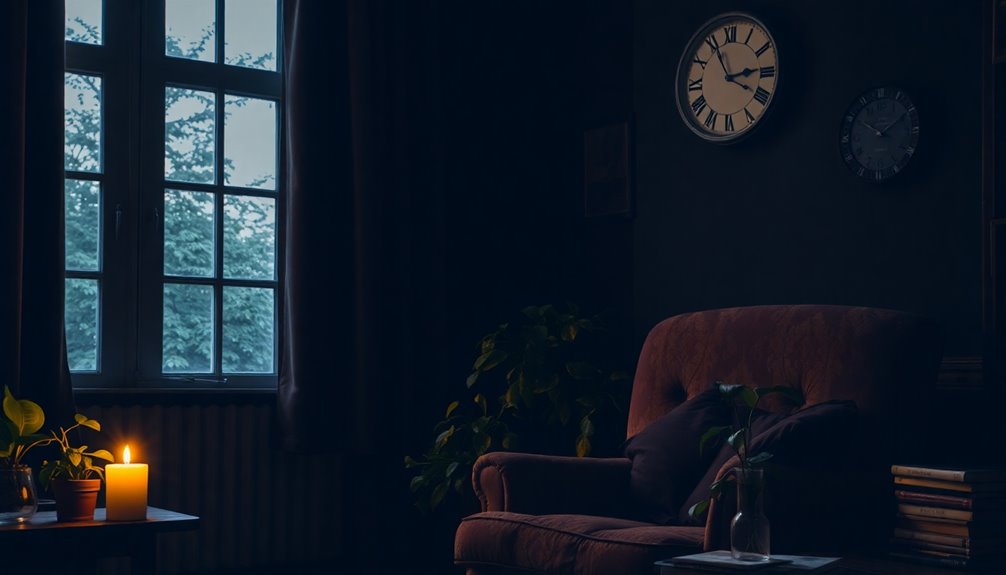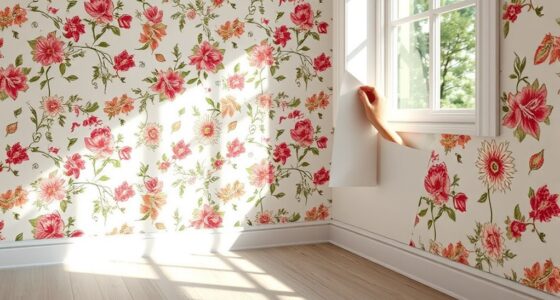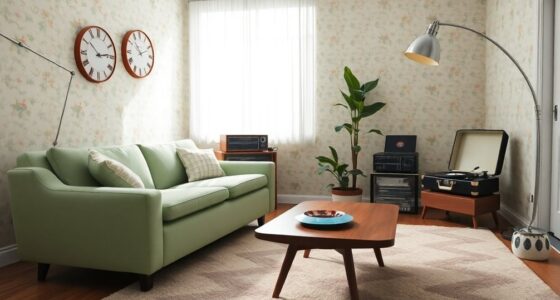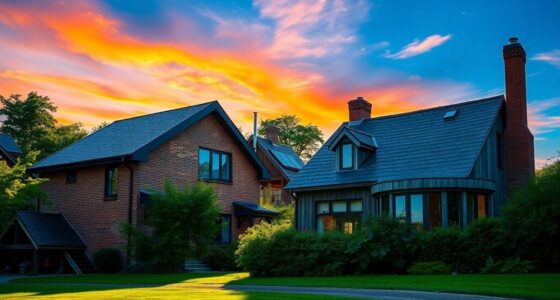You might notice many people keep their homes dark for several reasons. First, it offers a sense of privacy and security, especially in busy neighborhoods. Aesthetic preferences also play a role, as dark colors create dramatic contrasts in design. Psychological effects can't be ignored either; while darkness might feel cozy, it can also escalate feelings of anxiety and irritability. Ultimately, historical influences, such as gaslight era practices, still shape today's choices. Each reason intertwines, making darkness a complex topic. If you explore further, you'll uncover even more layers of this intriguing phenomenon.
Key Takeaways
- Keeping homes dark enhances privacy by limiting visibility from outside, creating a sense of security.
- Cultural traditions and historical practices often promote dim environments as a means of protection.
- Dark colors and minimalist designs contribute to modern aesthetics, making spaces feel stylish and sophisticated.
- Prolonged darkness can lead to negative psychological effects, such as increased irritability and disrupted sleep patterns.
- High foot traffic areas may encourage homeowners to maintain darker settings to avoid unwanted attention and preserve their privacy.
Reasons for Keeping Homes Dark

When you keep your home dark, you might feel a greater sense of privacy and security, as many believe that dim environments deter prying eyes from outside.
Past experiences with neighborhood safety concerns can lead you to draw curtains, minimizing visibility into your space. If you've had age-related eye surgeries, you might find sensitivity to bright light drives your preference for darker settings, reducing discomfort.
Additionally, you may want to protect your furniture and rugs from sunlight damage, prompting you to keep those curtains tightly closed.
Cultural habits and traditions also play a role, as past generations often emphasized darkness as a means of safety.
Ultimately, these factors create a cozy atmosphere that feels both secure and private.
Aesthetic Preferences in Design

When you explore dark color trends in home design, you'll notice how they create a striking aesthetic that can elevate your space.
Embracing minimalist design principles, dark hues offer clean lines and a modern vibe that resonates with today's architectural styles. Additionally, just as haute couture emphasizes intricate details and artistry in fashion design, dark color schemes can enhance the sophistication and elegance of a home interior.
Dark Color Trends
As dark colors continue to dominate design trends, homeowners are increasingly drawn to their striking aesthetic appeal. Dark siding enhances architectural details and creates dramatic contrasts that captivate the eye.
Here are three reasons why you might consider this trend:
- Elegance: Dark hues evoke the beauty of natural elements, offering a sophisticated look reminiscent of dark stones and rich soils.
- Maintenance: They effectively hide dirt and stains, reducing upkeep compared to lighter shades.
- Modern Integration: Dark colors align with contemporary design principles, seamlessly complementing large windows and metal accents while promoting energy efficiency. Additionally, the use of natural materials in dark tones can further enhance the rustic charm of modern farmhouse designs.
Embracing dark color trends not only elevates your home's visual impact but also aligns with practical and modern aesthetic preferences.
Minimalist Design Appeal
Dark color trends seamlessly connect to the allure of minimalist design, where simplicity and sophistication reign. By opting for dark colors, you embrace modern aesthetics that highlight sleek lines and minimal ornamentation. This choice not only enhances architectural details but also reflects the influences of Scandinavian and industrial styles, which prioritize functionality. Additionally, the use of textured fabrics adds warmth and comfort, creating a balanced environment.
Here's a quick comparison of minimalist design elements:
| Element | Dark Colors | Modern Aesthetics |
|---|---|---|
| Visual Impact | Striking contrasts | Clean lines |
| Emotional Appeal | Evokes elegance | Understated beauty |
| Nature Inspiration | Dark stones & soils | Blurred indoor/outdoor |
Incorporating dark hues creates a contemporary vibe, marking a shift towards sophistication that resonates with today's homeowners.
Psychological Effects of Darkness

Though many people find comfort in dim lighting, prolonged exposure to darkness can lead to significant psychological effects.
Spending too much time in low-light environments can negatively impact your mental well-being. Here are a few consequences to contemplate:
- Increased Irritability: Constant darkness can elevate your mood swings, making you feel more frustrated or short-tempered.
- Disrupted Sleep Patterns: Low light can throw off your circadian rhythms, leading to sleepless nights and groggy days.
- Heightened Anxiety: You might feel more isolated or anxious, as the absence of natural light can intensify feelings of gloom.
Additionally, maintaining hydration and nutrition is essential in mitigating some of these psychological effects, as both play a crucial role in overall mental health.
Embracing natural light can help counter these effects, promoting a healthier and more balanced state of mind.
Health Implications of Low Light

While many people appreciate the cozy ambiance of low-light environments, the health implications can be quite concerning. Prolonged exposure to low light can disrupt your circadian rhythm, causing sleep disturbances and fatigue. Here are two reasons to reconsider low-light living:
| Health Concern | Description | Emotional Impact |
|---|---|---|
| Sleep Disruption | Low light disrupts your natural sleep cycle | Increased fatigue |
| Vitamin D Deficiency | Lack of sunlight raises risks of serious diseases | Heightened anxiety |
| Seasonal Affective Disorder | Dark environments can lead to depression | Feelings of hopelessness |
| Headaches and Migraines | Insufficient light worsens sensitivity | Chronic discomfort |
| Stress and Anxiety | Constant darkness can increase stress levels | Diminished emotional well-being |
It's essential to balance light in your home for better health. Research has shown that digital literacy programs can help alleviate feelings of isolation that may arise from low light living. Always check the Terms of Use to understand the implications fully.
Safety and Privacy Concerns

Many people choose to keep their homes dimly lit to enhance privacy and security. By drawing curtains or blinds, you're limiting visibility from the outside, especially in areas with high foot traffic.
Past encounters with crime or peeping Toms can heighten your concerns and lead you to avoid exposing your living space.
Here are three reasons you might prioritize safety and privacy:
- Protection from prying eyes: Keeping your home dark makes it harder for neighbors or passersby to see inside.
- Cultural influences: Family traditions may emphasize the importance of privacy, shaping your preferences.
- Sensitivity to light: If you've had eye surgeries or are sensitive to bright light, creating a darker environment feels more comfortable.
Alternatives to Complete Darkness

If you want to maintain a balance between privacy and light in your home, several alternatives can help you achieve that. Consider using privacy shears or sheer curtains for a welcoming atmosphere that allows natural light in while keeping prying eyes out. Adjustable blinds give you the flexibility to control light levels without sacrificing privacy. Window films can block harmful UV rays while brightening your space, protecting your furnishings. Enhance your room with strategic lighting solutions like lamps and mirrors, or leverage smart home technology to automate your lighting and window coverings, improving energy efficiency. Additionally, consider incorporating an air purifier to further enhance your indoor environment and reduce allergens while maintaining a pleasant ambiance.
| Alternative | Benefit |
|---|---|
| Privacy Shears | Maintains privacy while allowing light |
| Adjustable Blinds | Flexible light control |
| Window Films | Blocks UV rays, protects furnishings |
| Smart Technology | Automates light management for comfort |
Historical Context of Dark Homes

Throughout history, the design of homes has often reflected the lighting technology and cultural norms of the time, leading to darker interiors.
You might notice several factors that contributed to this trend:
- During the Gaslight Era (1820-1900), homes relied on gas lighting, creating a dimmer ambiance than today's electric lights.
- Smaller windows were common in many homes, limiting natural light and helping retain heat, which resulted in gloomier spaces.
- Heavy drapery and dark wall colors were popular in the 19th century, believed to absorb light and evoke a cozy atmosphere.
These choices not only protected valuable furnishings from fading but also aligned with cultural preferences for a more subdued aesthetic, cementing the darker vibe of historical homes.
Natural Light vs. Artificial Light

While artificial light has its place in modern homes, relying too heavily on it can dampen your living environment.
Natural light is essential for your mental well-being, as sunlight exposure helps regulate your mood and circadian rhythms, reducing the risk of conditions like seasonal affective disorder (SAD).
Artificial lighting, although useful, often lacks the full spectrum of sunlight, creating a less inviting atmosphere.
Prolonged dependence on artificial light can lead to eye strain and discomfort, especially in spaces with limited natural light.
By leveraging smart home technology, you can strike a better balance between natural and artificial light, enhancing energy efficiency while keeping your surroundings bright.
Prioritizing natural light can boost your productivity and overall happiness at home.
Influence of Design Movements
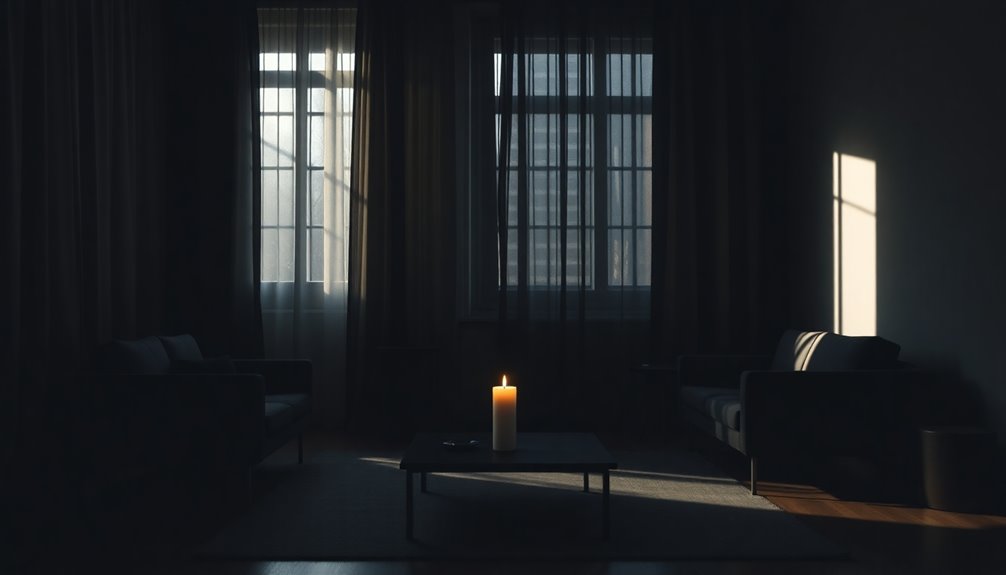
Natural light and artificial light play significant roles in how we perceive our homes, but design movements also shape our choices regarding color and ambiance.
Contemporary styles like minimalism and Scandinavian design embrace dark palettes, creating sleek, modern aesthetics. Here are some key influences:
- Industrial Aesthetic: Raw materials and functional design utilize dark colors, enhancing visual impact and complementing architecture.
- Dark Siding Trend: This choice aligns with clean lines and minimalism, emphasizing architectural expression in modern homes.
- Shift in Preferences: Homeowners increasingly favor dark shades, reflecting a break from traditional lighter tones to embrace contemporary styles.
These design ideologies encourage you to adopt dark colors, transforming your living spaces into stylish statements of modernity.
Support and Communication Strategies

Open dialogue with your family can reveal why some prefer darker spaces, addressing concerns like anxiety or safety.
By discussing alternative privacy solutions, you can strike a balance between maintaining comfort and inviting natural light into your home.
It's important to explore these strategies to create an environment that supports everyone's needs. Additionally, understanding the impact of emotional well-being on personal preferences can help foster a more supportive atmosphere.
Open Dialogue Importance
Creating an environment where everyone feels comfortable discussing their preferences for a darker home is essential. Open dialogue can help uncover underlying anxieties or past experiences that shape these choices.
Here are three key strategies to foster that conversation:
- Listen Actively: Make sure to validate feelings and concerns about light and privacy, enhancing a supportive atmosphere.
- Consult Professionals: Bringing in medical insights can shed light on mental health aspects related to darkness, guiding better strategies.
- Provide Resources: Equip caregivers and family members with knowledge to comprehend and support these preferences, promoting well-being.
Alternative Privacy Solutions
Discussing preferences for a darker home naturally leads to exploring alternative privacy solutions that balance comfort and light.
You might consider privacy shears or sheer curtains, which maintain your privacy while letting natural light brighten your space.
Adjustable blinds offer you the flexibility to control light levels throughout the day, catering to your personal comfort.
Window films can block harmful UV rays while allowing light in, protecting your furniture from sun damage.
Additionally, strategic lighting solutions, like placing lamps and mirrors to reflect natural light, can create a welcoming atmosphere.
Finally, utilizing smart home technology lets you automate light management, enhancing energy efficiency while addressing privacy and safety concerns effectively. Integrating smart home devices can further optimize your lighting solutions, allowing for remote control and energy monitoring.
Frequently Asked Questions
Why Do Some People Keep Their Homes Dark?
You might keep your home dark for several reasons.
Maybe you feel more secure or comfortable in a dim environment, or perhaps you're sensitive to bright light after an eye procedure.
You could also associate darker spaces with privacy, allowing you to relax without feeling exposed.
Additionally, cultural habits or past experiences might influence your preference, making you choose a cozier, shaded atmosphere.
Whatever the reason, it's your personal choice that shapes your living space.
Why Are People Painting Their Houses Dark Colors?
You might be drawn to painting your house dark colors for their modern aesthetic and striking visual impact.
Dark exteriors highlight architectural details and align with minimalist design trends. Plus, they effectively hide dirt and stains, making maintenance a breeze.
If you love nature, dark shades can evoke the elegance found in stones and forests.
Ultimately, choosing dark colors gives your home a sophisticated, contemporary style that stands out in any neighborhood.
Why Do People Keep Their Blinds Closed All Day?
You might keep your blinds closed all day for several reasons.
It gives you privacy and security, especially if you live in a busy area.
You're also protecting your furniture from UV damage and creating a calming atmosphere that can help with discomfort from bright light.
Plus, keeping the blinds drawn can make you feel safer and more in control of your space, which can reduce anxiety and enhance your overall comfort.
What to Do if Your House Is Too Dark?
Imagine walking into a cave, where shadows swallow everything.
If your house feels too dark, it's time for a change. You can install sheer curtains to let in soft light while keeping your privacy.
Use adjustable blinds to control brightness throughout the day. Add warm LED lamps and mirrors to reflect light.
Consider lighter colors for your walls, creating an inviting space that lifts your spirits and brightens your daily life.
Conclusion
In the dance between light and shadow, you might find beauty in the dark corners of your home. It's more than just a choice; it's a reflection of your style, a sanctuary for your thoughts, and a shield for your privacy. As the sun dips below the horizon, those dimly lit rooms whisper stories of comfort and safety, inviting you to unwind. So, when you close the curtains, remember, you're not just shutting out light; you're crafting your own cozy retreat.
